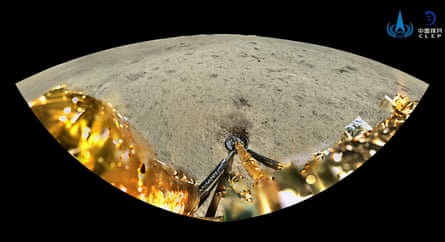China’s uncrewed Chang’e-6 probe is on its way back to Earth carrying the first samples from the far side of the moon, in a major achievement for Beijing’s space programme.
The probe landed on the lunar surface on Sunday, within one of the oldest craters on the moon – the South Pole-Aitken (SPA) basin – then spent two days gathering rock and soil samples using its drill and robotic arm.
After successfully gathering its samples, “a Chinese national flag carried by the lander was unfurled for the first time on the far side of the moon”, the China National Space Administration (CNSA) said.
CNSA has confirmed the probe is on its return journey, with its ascender module having “lifted off from lunar surface” and entered a preset orbit around the moon.

The development has been welcomed by the scientific community.
“This is a very important achievement,” said Prof Martin Barstow of the University of Leicester. “Only the USA and Russia have recovered samples from the moon, landing and then taking off again. It demonstrates an impressive capability in China’s space programme. It’s a technical feat to take off from the moon at all but even more challenging when carried out on its far side.”
Dr Romain Tartèse, of the University of Manchester, agreed. “So far it’s all proceeding according to plans for Chang’e-6, with the capsule containing the precious sample cargo on its way to the lunar orbiter. It’s enormously exciting as each step gets us closer to getting these samples back to Earth,” he said.
The far side of the moon – sometimes called the “dark side”, because it is not visible from Earth – is thought to offer new opportunities for research. Experts say the samples brought back by the probe could provide unprecedented insights into the formation and evolution of the moon and the solar system, answer questions about why the near and far sides of the moon are so different, and provide clues as to how Earth came to sustain life.
“I do not know if they have any plans for sharing samples outside China, but I hope they have and that we in the UK would get an opportunity to work on these. This would fit very well with our plans for sample return from Mars,” said Barstow.

Tartèse said he and his colleagues at Manchester University were also hoping to work on Chang’e-6 samples, noting they were previously involved in an international consortium with colleagues in Beijing to study samples from the near side of the moon returned by China’s earlier lunar mission, Chang’e-5.
“We very much hope we will have the opportunity to repeat this working on Chang’e-6 samples in coming months, as these samples from the lunar farside will likely provide us with key information on how the lunar crust was built, and on the bombardment history of the inner solar system during its first 500m years of evolution,” he said.
Scientists warned that the mission was not yet accomplished, as the container carrying the samples still needed to be transferred to a re-entry capsule that was due to return to Earth and arrive in the deserts of China’s Inner Mongolia region around 25 June.
“There remains two nerve-racking stages: first, docking of the ascent vehicle with the lunar orbiter, and then firing on the Earth return vehicle to get it to leave lunar orbit to return safely to Earth,” said Tartèse.
Barstow said: “They must return to Earth orbit safely and then the mission must survive re-entry. But, so far so good.”
Article From & Read More ( China’s lunar probe on way back to Earth from far side of the moon - The Guardian )https://ift.tt/ihRyT4t
Science
No comments:
Post a Comment